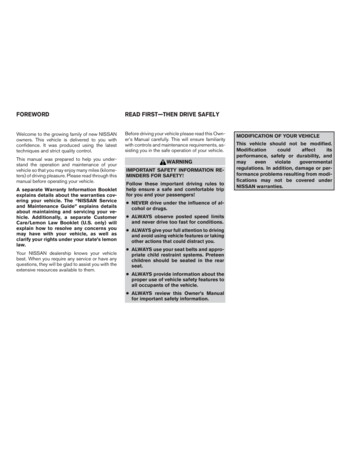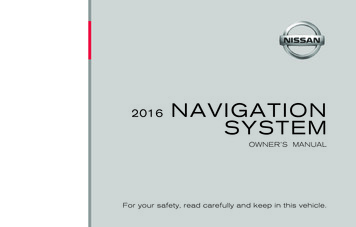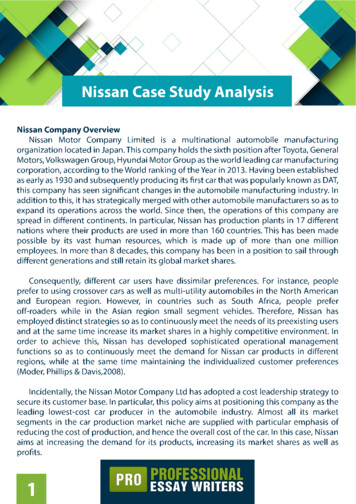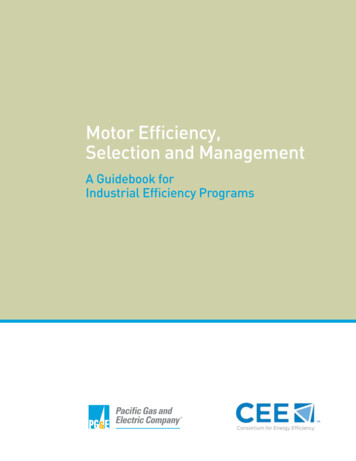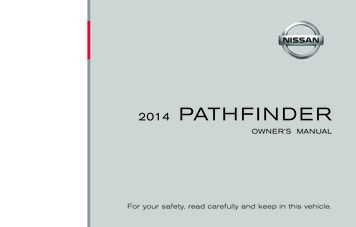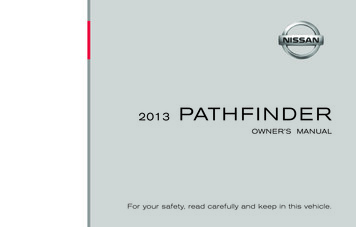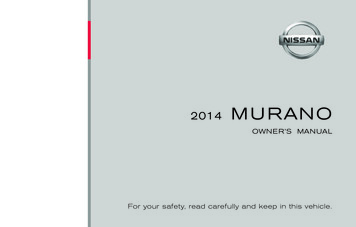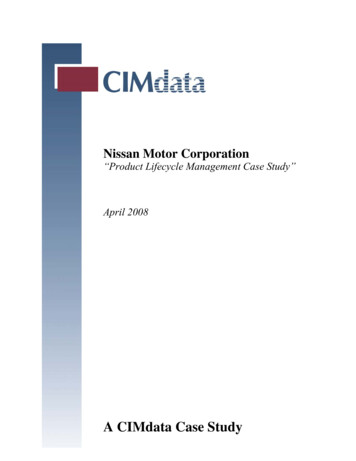
Transcription
Nissan Motor Corporation“Product Lifecycle Management Case Study”April 2008A CIMdata Case Study
Nissan Motor Corporation“Product Lifecycle Management Case Study”April 2008Produced byCIMdata, Inc. http://www.CIMdata.comCIMdata, Inc.3909 Research Park Drive, Ann Arbor, Michigan 48108Tel: 1 (734) 668–9922 Fax: 1 (734) 668–1957CIMdata is a Registered Trademark of CIMdata, Inc.Copyright 2008 by CIMdata, Inc. All rights reserved.
Nissan Motor Corporation“Product Lifecycle Management Case Study”Today’s automotive industry is global, both in terms of customers spread acrossmultiple regions (from mature and emerging markets) and manufacturers andsuppliers scattered around the world. The issue from an original equipmentmanufacturer’s perspective is how to respond to and best satisfy complicateddemands while at the same time delivering attractive vehicles at higher qualitylevels, at the right time, and at a reasonable price. Nissan appears to have anappropriate answer to achieving these goals through product and processinnovation enabled by a sound PLM approach and solution. In the end, Nissanhas realized it with “Shift the Proving Ground” to deliver attractive models withtheir concept—“Trusted Driving Pleasure.”1. IntroductionNissan’s plans call for the utilization of this newdevelopment environment on all vehicle programs by 2010.Regardless of your interest in the design and manufacturingprocesses related to the vehicle you will purchase or arecurrently driving, the latest model you own most likely hasbeen produced by digital technology operating within acomprehensive Product Lifecycle Management (PLM)environment. This is certainly the case when one considersthe latest vehicles from the Nissan Motor Corporation(Nissan), such as the Infiniti G37 Coupe (Skyline Coupe inJapan) the top of their brand (shown in Figure 1). Nissan,founded in 1933 and headquartered in Tokyo, Japan, hasextensively deployed and utilized a fully digital PLMenabled environment to design both the vehicle and theprocesses used to manufacture it. Nissan has coupled their“development environment of the future” initiative to newstrategic business concepts to increase their success in theglobal automotive market. The Infiniti G37 Coupe is thefourth vehicle program in which Nissan has utilized thisnew digital environment to bring a new model to market.The world of vehicle design and manufacture is evolvingalong with the Information Technology (IT) applicationsoftware used to support the process throughout all phasesof the vehicle program’s lifecycle; from customerrequirements and conceptual design, to detail andproduction design and manufacturing, to sales support andmaintenance services. The vehicle developmenttechnologies that support the design of both the vehicle andits production processes are now distributed throughout theorganization on every engineer’s workstation. Gone are thedays when hundreds of physical prototypes had to beproduced by hand just to satisfy the requirements of onespecific market. There is no doubt that today’s vehicledevelopment environment is much more complex than thatof the past. Today’s modern vehicle developmentenvironments provide a wealth of well-defined product andprocess information to all those in the organization thatrequire it, enabling them to more effectively perform theirtasks in the development of a vehicle thatmust satisfy the requirements of multiplemarkets.Figure 1—The Latest Model from Nissan: The Infiniti G37 Coupe(Skyline Coupe in Japan, Courtesy of Nissan)Nissan Motors PLM–A CIMdata Case StudyToday’s automotive market is global. Nolonger can Nissan or any other automotivemanufacturer design and deliver a vehicle toonly one market in a cost-effective manner.No longer can Nissan afford to develop anew vehicle in one market and hope that itwill satisfy the requirements of others. As aresult, these development programs need tobe global and multi-cultural in nature. Thiscomplexity is made more severe by the factthat today’s vehicle is filled with an ever-Page 1
increasing number of complex electromechanical systemsthat include a significant amount of embedded software. Asif this isn’t enough, the typical automotive manufacturerfinds itself under an ever-increasing regulatory weightwhere each country where the product is to be sold andserviced continues to add requirements for safety,environmental concerns, etc.Future,” are at the core of Nissan’s values and businessphilosophies.Much of the information technology that is currently usedto digitally create, design, and manufacture Nissan’svehicles has been utilized in the aerospace industry forsome time. Its availability to the automotive industry, inmany ways, means that a new era of product and processdefinition is now in place enabled by today’s PLMsolutions, which include a host of enabling technologiessuch as CAD, CAM, CAE, PDM, Digital Manufacturing,and visualization.Even under these circumstances, today’s global automotiveoriginal equipment manufacturers (OEMs) have becomemore competitive when one considers the standardmeasures of Quality, Cost, and Time (QCT). As a result,they are increasingly challenged to differentiate themselvesand to respond to market demand in mature markets likeNorth America and Japan, some growing markets inEurope, and very active and evolving markets indeveloping counties like India and China. This means thateach and every OEM needs to establish its own strategicoriented business solution to sustain and grow the companyin this highly competitive global market. Nissan is noexception to this rule. They are being challenged toinnovate the company, and as a result are focusing onimproving their Product Definition Model, which inNissan’s terms includes the process of creation,dissemination and use, and management of the productdefinition, through the extensive deployment of PLMenabling solutions.CIMdata defines Product Lifecycle Management (PLM) asa strategic business approach that applies a consistent set ofbusiness solutions in support of the collaborative creation,management, dissemination, and use of product definitioninformation across the extended enterprise from concept toend of life—integrating people, processes, and information.PLM forms the product information backbone for acompany and its extended enterprise. It is composed ofmultiple elements including: foundation technologies andstandards (e.g., XML, visualization, collaboration, andenterprise application integration), information authoringtools (e.g., MCAD, ECAD, and technical publishing), corefunctions (e.g., data vaults, document and contentmanagement, workflow and program management), andfunctional applications (e.g., configuration management),and business solutions built on the other elements. Nissan’sPLM concept is illustrated in Figure 2.Nissan’s approach to marketing and selling cars is evolvingfrom a classical model that dates back to the 1970’s. Thislegacy model focused on providing a vehicle of equalToday’s globally competitive automotive industry demandsquality and performance at a lower price point than itsPLM—a business strategy that seeks to enable innovationcompetitors. This approach was very successful in gainingof an enterprise’s product and product definition relateda market position in newmarkets such as North AmericaConcept PhaseDevelopment PhaseProduction Phaseand Europe. Nissan built onpreciseApplied ModeltheirearliersuccessbyCADconsistently seeding the marketsprecisepreciseGlobal Marketthey entered, especially NorthApplied ModelApplied ModelApplied ModelSuppDeploymentlierApplied ModelPFPFPFPFAmerica, with their signatureBOM ÅEñ¹ïWê î\UBUBUBUBtechnological improvements andÅEã§ópâªï]âøby focusing on superiorcustomer service programs.Parts PropertyCost / Weight/Material/Production SiteNissan’s classical approach hasevolved and expanded to includea focus on safety andBOPenvironmental issues, as well asan enhanced focus on theirhistoric position as a leader indeliveringhigh-performance CAE/CATResult of TestTemplateResult of SimulationResult of Digital TestResult of sPLMConcept:“EmpowermentbyPLM”marketing campaigns, “Driving(Courtesy of Nissan)Pleasure” and “Shifting to theOHHPÅúÅúÅúÇrÇdÇcÇrÇdÇcÅú Åúê ãKIPLÅúÅúÅú ÅúÇrÇdÇcÇrÇtÇuÅúÇlÇoÇuÅúÇvÇ �cÅúÅÚ1 ÅÚ2 îÔé‘ëÃêÆîÐê é‘ëÃé‘ëÃêÆîÐê êÆîÐê ÅEÅEÅEÅEÅEPage �RîÔîRîÔîRîÔÅúÅÚ1 ÅÚ2 ÅÚ3ÅEÅEÅEÅEÅEîRîÔÅEÅEÅEÅEÅENissan Motors PLM–A CIMdata Case Study
processes, making sure that the enterprise’s people,processes, and technologies are continuously improved in aclosed-loop fashion. The importance of PLM is heighteneddue to the fact that today’s OEMs need to continue toshorten time-to-market while at the same time designingmore complex globally-applicable vehicles and associatedmanufacturing capabilities.2. Issues: Challenges at NissanAt the 2007 general meeting of shareholders, Mr. CarlosGhosn, Nissan’s CEO, described Nissan’s current andfuture state, and specific strategies to be executed toachieve the goals. Mr. Ghosn’s main message includedbuilding Nissan’s brand image by delivering internally andexternally attractive designs, driving pleasure (see Figure3), and a high level of customer service. He also reinforcedNissan’s intent to stay competitive with regard to quality,prices, and availability. Mr. Ghosn also mentioned thecompany’s continued focus on people investmentthroughout their global operations and motivating theirpeople to work more efficiently and cross-functionally.Finally, Mr. Ghosn stressed Nissan’s need to continue tolead through innovation with a focus on R&D spending onnew technologies, safety features, and meeting society’senvironmental expectations.new CEO of Nissan who had come from Renault S.A.,made a commitment to Nissan’s renewal. The initialprogram, “Nissan Revival Plan” (NRP) as it was called,defined a set of messages that included specific timeframesfor corporate improvement. Over the years, the programwas extended and renamed “Nissan 180.” This programfocused on profitable growth based on the completion ofthe NRP. This program in turn was transformed into the“Nissan Value-Up Plan” program, which focused onsustaining growth by improving value throughout all phasesof the product lifecycle. Nissan’s revitalization programsare well known in the industry and have been instrumentalin Nissan’s financial success.Under the NRP program, Nissan formed a number of CrossFunctional Teams (CFTs). Each team was comprised of anumber of individuals throughout the organization, eachwith a different background. The purpose of these teamswas to improve and solve, through cross-functionalcommunication and teamwork, a set of long-time businessissues that had plagued the organization. These issuesincluded the lack of profit orientation, lack of customerorientation, lack of cross-functional and cross-border workpractices, lack of sense of urgency, and lack of sharedvision and common long-term plan. In all, Nissan formedthe following nine CFTs: Business Development,Purchasing, Manufacturing & Logistics, R&D, Sales &Marketing, G&A, Finance Cost, Product Phasing Cost, andOrganization. Each of these teams was instructed tochallenge the current status of the organization and themanner in which it works, and to develop plans forimprovement.2.1 Shifting the Proving Ground: TheNeed for Innovative Products andProcessesFigure 3—Nissan’s Core Value: Trusted Driving Pleasure(Courtesy of Nissan)Mr. Ghosn’s message was a result of Nissan’s continuedand long-term effort to revive and modernize itself—aneffort that began in the late 1990’s when finances were sofragile that the company could not afford to maintain itsreputation for technological innovation, the traditional coreof its brand identity. In the autumn of 1999, Mr. Ghosn, theNissan Motors PLM–A CIMdata Case StudyThe CFT responsible for challenging the way R&Doperated spent much of its time studying and discussinghow new and innovative engineering processes could meetNissan’s changing business model—a model that sought toimprove profitability and competitive position as well asintroduce more global products supported by a globallyoperating organization and supply base. This CFT neededto find and establish a best practice-based methodology thatwould consistently deliver the right model to the rightcustomer at right time and at the right profit level. Onespecific area of attention for this R&D-focused CFT wasthe body (herein, “body” refers to the Body-in-White(BIW) and other associated parts and components exceptfor the chassis and powertrain; Nissan often refers to this asUpper Body design, “Uwaya” in Japanese). For Nissan toPage 3
improve in this critical vehicle design area, the CFT neededto embed QCT best practices, including BIWmanufacturing process design into the overall body designprocesses. Ultimately, the CFT felt that this requiredcapturing and managing product and process engineeringknow-how in an enterprise database so that theseintellectual assets (i.e., corporate knowledge) could be reused across vehicle programs. The implementation of suchan environment has resulted in Nissan’s ability to delivervehicles in shorter development cycles while at the sametime keeping and increasing their quality, lowering costlevels, and providing more attractive models to the globalautomotive market.It is interesting to note that over the last 30 years, Nissanhas seen a 20% increase in the amount of developmentwork required to design a new vehicle platform. Accordingto Nissan, this increase is a direct result of the increase invehicle complexity due to increased safety andenvironmental demands, and the mechatronics content ofthe vehicle. Nissan points out that this 20% increase wouldhave been much higher were it not for the reduction inworkforce they have been able to accomplish due to asignificant increase in product and process knowledge andpart re-use. Overall, this increased complexity has placedadditional pressure on the organization to implement newinnovative engineering processes and/or systems tooptimize its workforce further to address these additionalcomplexities.One of the major initiatives that the R&D CFT seriouslyconsidered was the deployment of additional informationtechnology (IT) in support of Nissan’s developmentprocess. By doing so, the CFT hoped to gain efficiencyduring the preparation of product definition informationresulting in a dramatic reduction of development time. Inaddition, the CFT hoped that this new and innovative ITsupported process would facilitate the digitization of theirproduct lifecycle processes since it would be enabled withfully-developed 3D product models—models that would beleveraged throughout the lifecycle and the extendedenterprise to support the definition of dies, fixtures, andcomplete manufacturing processes, and would be used toensure the availability of quality product information toeveryone who needs it.The R&D CFT also sought to extend the initial enablementof product development processes, especially the bodydesign processes, with additional focus on simulation andvalidation techniques. The implementation of these newtechniques and supporting technologies have alreadyproven to accelerate product development and increaseproduct quality from styling freeze (i.e., all productdefinition information is ready so that productionPage 4engineering and physical prototypes can be prepared by thevarious working groups involved, including the suppliercommunity) to Start of Production (SOP) by decreasing thenumber of physical prototypes and increasing the speed atwhich manufacturing process optimization has taken place.To realize this goal, Nissan has had to move from threephysical prototypes to one while at the same time puttinginto place technologies that supported their shift fromphysical testing to digital testing as the proving ground.As part of the NRP, the R&D CFT and other productdevelopment supporting CFTs and their implementedimprovements have resulted in a higher level of processconfidence and a reduction of the development cycle (i.e.,from styling freeze to SOP) of more than ten months (from21 months to 10.5 months). Nissan reports that in theSpring of 2001, they evolved the NRP into the Value-UpInnovation of Product, Process and Program (V-3P) thatwas designed to focus on design and delivery of moreattractive vehicle models to the global automotive market.3. DeploymentNissan’s V-3P has proven to be a significant step forwardfor Nissan. This program, which included a sizeable budgetfor purchasing and implementation of PLM-enablingtechnologies (e.g., CAD/CAM/CAE/CAT and PDM, andthe necessary hardware), is the responsibility of Mr. KeigoFukushi, General Manager and V-3P Program Director.Beyond the technology element of the program, it alsoincluded funding and resources for people, including a newproduction engineering team, and application development.Mr. Fukushi works within the Process InformationManagement Department. This department is part ofNissan’s R&D Engineering Management Division based inAtsugi, Kanagawa, Japan. The commitment made by theorganization with regard to V-3P has been significant. Theprogram’s initial goal, as defined at its launch in the Springof 2001, was to define, implement, and utilize the new V3P process to design and deliver a completely new globalvehicle platform by the September 2004 Paris Auto Show.This new vehicle, known as the “Tone” concept model, wassold as the “Note” in Japan initially and supported by themarketing phrase “SHIFT compact flexibility,” whichNissan believed captured its V-3P vision and intent.3.1 Defining theV-3P Program and itsGoalsNissan simply and clearly defines V-3P as follows:Nissan Motors PLM–A CIMdata Case Study
The activity of dramatically improving QCTmetrics by creating and capturing Nissan’sKnow-How about “KURUMA-ZUKURI” (i.e.,vehicle design and manufacture best practices)into an enterprise accessible databaseConsistently executing the development processfrom Styling Freeze to SOP in 10.5 monthsutilizing one physical prototype prior to formalproductionTo achieve the V-3P vision, Nissan quickly realized that itneeded to define and make an extensive set of changes toits vehicle development process and their fundamentalapproach to standardization of various aspects of design.3.2 StandardizationFor many years, standardization has been a commonbuzzword throughout the automotive and other industries.In many ways, the standardization of parts and componentsis a common expectation in the automotive industry (i.e.,defining and utilizing common parts, components, andsystems across multiple vehicle platforms) and is somethingthat is well supported by today’s PLM solutions. For mostcompanies, this has meant standardization around singleparts or simple assemblies in order to reduce internal costsor costs associated with purchasing. For some, this hasmeant using existing designs and morphing them into newparts and assemblies. Unfortunately, these typicaltechniques tend to not deliver QCT benefits after SOP.Because of this, Nissan decided that their V-3P processneeded to be more advanced and proactive, deliveringbenefits throughout the product lifecycle. They felt that anincremental improvement was not sufficient.The ultimate goal for Nissan’s standardization directive, inV-3P terms, was to create a complete product and processdefinition; one that described the entire vehicle, includingthe production process definition and other information thatcovered all of the product and process issues within thescope of developing and delivering a car to the market.From the beginning, V-3P’s goal was to establish Nissan’s“know-how” database related to the design and productionprocesses; namely establishing “MONO-ZUKURI” (i.e.,equal meaning to KURUMA-ZUKURI, but a more generalindustry term) know-how as the standard supported bysolid and proven processes that are enabled by technologythat support history-based 3D CAD architecture instead ofthe old paper-based system. Overall, Nissan is able to usetemplates that enhance the database’s content and contextfor further model development within the context ofvalidated best practices. Nissan believes that 40% of thoseprocesses may be standardized elements and thereforeNissan Motors PLM–A CIMdata Case Studyshould be automated, and that the remaining 60% are morelikely to be vehicle model-specific processes that include30% of an engineer’s decision process in design. Nissannames it “Know-How CAD” and templates were also usedto incorporate design process best practices for re-use andimprovement as required in support of QCT initiativesacross the entire product lifecycle. Nissan named thisstandardization directive “Digitalized Knowledge.”3.3 Process ChangesHistorically, Nissan’s engineering process (used to defineproduct definition information up to SOP) was comprisedof two major phases. The first phase was partiallyconcurrent in nature, with Styling, Design, Production, andProduction Preparation tasks executing simultaneously todefine the product definition information and to provide itto production engineering as a styling freeze. The secondphase focused on prototyping production to developadditional rich product information including productionprocess definitions, and actual vehicle test and validationdata taken from the three physical prototypes constructedprior to SOP. With Nissan’s deployment of 3D modelingtechnologies in the late 1990’s, Nissan’s engineeringprocess gained a certain level of efficiency and cut the timeit took to get to SOP to approximately 20 months—comparable to other Japanese OEMs and shorter than mostEuropean and US-based OEMs who were takingapproximately 35 months at that time. For Nissan, thisimprovement was not good enough.To achieve the desired efficiency gains, Nissan had to findand implement a more advanced approach. The approachNissan took sought to incorporate richer and more maturecontext into the product definition information by the endof Styling Freeze. Nissan accomplished this by involvingmore partners in the development process earlier, and byfocusing on the use of only one physical prototype prior toSOP. In many ways, this forced Nissan to greatly enhancethe maturity of their vehicles’ virtual product and processdefinition, including the validation of this information priorto SOP. Without doing this, Nissan would not be able tosuccessfully assembly the vehicle at SOP. At the core ofthis approach is what Nissan described as “DigitalCollaboration.” This collaborative approach simultaneouslyinvolves participants from various developmentorganizations, including Styling, Design, Production, andProduction Preparation, in a tight partnership. This process,which is now called “Digital Lot,” is a very innovativeprocess—one that could not have been achieved withoutshifting Nissan’s culture and how its people work,dramatically changing multiple processes, and aggressivelyPage 5
Figure 4—Accelerating Production Engineering Studies(Courtesy of Nissan)using IT in support of collaborative engineering and thedeployment of simulation and validation technology forwhat Nissan describes as “Digital Evaluation.” Figure 4summarizes Nissan’s improvements gained throughstandardization and digital evaluation.3.4 Process Innovation andStandardization: A HistoricalProspectiveTo understand how Nissan was able to shift to a digitalenvironment as defined by the V-3P program, it isimportant to review the path and various product datarelated improvement activities that Nissan has taken overthe years. Nissan recognized that the utilization of 3Dmodels and the proper management of product informationare essential to enable an effective digital environment fordefining the virtual product design and productionprocesses, as well as linking the virtual product with thephysical product. Much of this was due to Nissan’sexperiences in switching from their corporate homegrownCAD system, based on 3D proprietary wire-frametechnology, to a commercially-available 3D solids basedCAD system (i.e., I-deas from SDRC, now supported bySiemens PLM Software) in the mid-1990’s.Nissan’s recognition that they needed to standardize on acommercially-available 3D CAD package was also due totheir understanding that they needed to support their globalenterprise, including the integration of its suppliers. Fromthe beginning, Nissan expended a significant effort onincorporating their design process into I-deas and utilizingPage 6the 3D model as part of a fairlycomprehensive Digital Mockup andDesign Review (DMDR) process.Nissan’seffortsshortenedthedevelopment cycle to approximately 20months and allowed them tosuccessfully create production moldswithout physical prototyping, in aprocess Nissan calls “One Shot FormalMold.” In the area of supplierintegration, Nissan applied EuropeanOEM-styled modular responsibilities,where suppliers deliver integrated andcompletely assembled modules. Theadoption of this approach has providedNissan with significantly moreflexibility for the introduction of newmodels.Nissan has spent a significant amountof time and effort to ensure thatproduct definition information is prepared appropriatelyand accurately within a streamlined and digitalized manner.Their ability to do this is a key element in innovating theirvehicle development process under the V-3P program.Nissan calls this ability “Data-Show” and it represents aninitiative in the activity of product data definitionmanagement. “Show” here is the Japanese pronunciationfor the Kanji character pictured in Figure 5. “Show” holds asignificant meaning for Nissan; it can be translated as“Core,” “Important Role,” or “Pivotal,” and it may expressan extended meaning of “Balancing” or “Impact” by addingone or more small Japanese characters. As fundamental as“Data-Show” is for Nissan, their dedication to ensuring thataccurate product information is given to the next step in thevehicle development process is also important. Withoutbeing able to do so, Nissan would not be able to createaccurate designs for simulation and validation of the digitalproduct and manufacturing processes—keys to an efficientFigure 5—Symbolized, Japanese Character “Show”Represents Preparing in Practice Accurate ProductInformation at NissanNissan Motors PLM–A CIMdata Case Study
and productive PLM environment. It is interesting to notethat Nissan owns and tracks a proprietary metric thatmeasures the maturity of product definition information(i.e., its accuracy) for new parts. Nissan reports that theyhave seen steady improvement with regard to this metric(they have reported that they achieved 95% in 2004).3.5 New Process ExamplesThis section lists a few specific examples to provide abetter understanding of the types of processes that Nissanhas implemented. StandardizedDesign—Nissanexaminedexisting paper-based design processes, andextended them with the inclusion of additionalproduction engineering process content andsupplier community collaboration, and thendefined and established a new procedure called“digital flow.” This procedure leverages anintegrated database environment that containsstandard structures, i.e., templates containinghistory-based 3D solid CAD data modeled in Ideas. Design engineers working within thisenvironment can create geometry whilefollowing the appropriate quality standards andtaking advantage expertise and know-how viathe environment’s web interface (see Figure 6). Figure 6—Knowledge Database with Template Approach(Courtesy of Nissan) Performance Analysis—In this area, Nissan hasspent a significant amount of effort expandingthe availability and use of simulation andvalidation technologies in support of virtualtesting. As a result, Nissan has deployed severalsoftware applications, mainly from globalvendors, in support of conventional StructureAnalysis, Crash Analysis, Flow Analysis, EnginePerformance Analysis, Mechanical ling,andAnimation.Withtheimplementation of the V-3P program, NissanNissan Motors PLM–A CIMdata Case Study placed a specific emphasis on enabling virtualcrashing testing and other virtual testing thatwould support their desire to utilize only onephysical prototype. Nissan reports that theimplementation of these technologies hasallowed (so far) accurate and predicable digitalevaluation of approximately 45% of a vehicle’sitems. Nissan reports that they have successfullyapplied these digital evaluation technologies onthe 2003 Note program and in that vehicleprogram they were able to accurately evaluate95% of its thousands of items. According toNissan, this was the highest rate ever accuratelydigitally prototyped and it has validated that theycould reduce the number of physical prototypesused during development with predictable andaccurate analysis processes.Production and Plant Engineering—Asdescribed above, production engineering is nowsupported in the early design phase with KnowHow CAD, which provides the ability to reuseintellectual assets, which are now stored in adatabase. This is a major improvement over theold conventional process where information wasgathered based on physical prototyping. Nissanestablished two phases to validate productionprocesses (e.g., Press, Welding, Body, Resin,Powertrain,andAssembly)withtheimplementation of the V-3P program. Toaccomplish this, Nissan has implemented anumber of software applications in support ofProduct Process Simulation, Die ProductSimulation, Analysis Simulation, and DigitalTesting. With the support of these applicationsand the new processes they support, Nissan hasbeen able to more quickly transform the designsin the physical plant. Besides being able to reachthe SOP quicker, Nissan repo
comprehensive Product Lifecycle Management (PLM) environment. This is certainly the case when one considers the latest vehicles from the Nissan Motor Corporation (Nissan), such as the Infiniti G37 Coupe (Skyline Coupe in Japan) the top of their brand (shown in Figure 1). Nissan, founded in 1933 and headquartered in Tokyo, Japan, has

